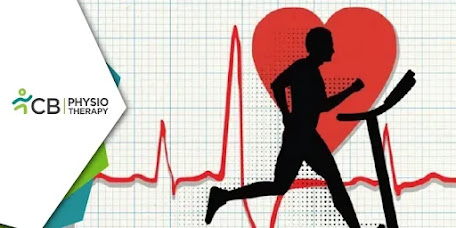Eccentric exercise is a form of resistance training that focuses on lengthening a muscle under tension. Unlike concentric movements, where muscles contract and shorten (such as lifting a dumbbell), eccentric exercises emphasize controlled muscle elongation (such as lowering a dumbbell). This technique is widely used in physiotherapy for rehabilitation, injury prevention, and strength development. Recent research has also highlighted its benefits in improving cardiovascular health. In this blog, we will explore how eccentric exercise enhances strength, mobility, and heart health, and why it should be an integral part of physiotherapy programs.
Understanding Eccentric Exercise
Every movement in strength training consists of three phases:
1: Concentric Phase — Muscle shortens while producing force (e.g., lifting a weight).
2: Eccentric Phase — Muscle lengthens while resisting force (e.g., weight lowering).
3: Isometric Phase — Muscle remains the same length while contracting (e.g., holding a squat position).
Eccentric exercises focus on the lengthening phase, which requires greater force production. This leads to significant muscle remodeling and adaptation, making it an essential component of physiotherapy and athletic training.
Science Behind Eccentric Exercise
Eccentric contractions engage more fast-twitch muscle fibers, which are responsible for strength and power. This increases muscle tension, leading to enhanced muscle growth, strength, and endurance. Additionally, eccentric movements cause micro tears in muscle fibers, which stimulate repair and strengthening, making them highly effective for rehabilitation and injury prevention.
Moreover, eccentric training requires less oxygen compared to concentric exercises, making it beneficial for individuals with cardiovascular conditions. The lower metabolic demand allows for greater workload management while improving overall endurance and heart function.
Benefits of Eccentric Exercise in Physiotherapy
1. Strength Development
Eccentric exercises allow for greater force production at lower energy costs, making them ideal for building muscle strength. This is particularly beneficial for:
· Individuals recovering from injuries
· Elderly patients experiencing muscle loss (sarcopenia)
· Athletes looking to enhance performance
2. Injury Prevention and Rehabilitation
Eccentric training is commonly used in rehabilitation programs for:
· Tendon injuries (e.g., Achilles tendinopathy, patellar tendinitis)
· Ligament recovery (e.g., ACL rehabilitation)
· Muscle strains (e.g., hamstring injuries)
By gradually increasing the load on the affected area, eccentric training improves tendon stiffness and resilience, reducing the risk of re-injury.
3. Joint Health and Mobility
Eccentric movements place less stress on joints compared to concentric exercises. This makes them ideal for individuals with osteoarthritis or joint instability. Controlled eccentric training can:
· Improve joint range of motion
· Enhance flexibility
· Reduce pain associated with degenerative joint conditions
4. Neuromuscular Control and Balance
Eccentric training enhances coordination by improving neuromuscular efficiency. This is particularly beneficial for:
· Stroke rehabilitation
· Parkinson’s disease management
· Elderly patients prone to falls
By strengthening the stabilizing muscles, eccentric exercises improve balance and postural control, reducing the risk of falls and injuries.
5. Cardiovascular Benefits
Recent studies suggest that eccentric training positively impacts heart health by:
· Reducing blood pressure
· Enhancing vascular function
· Improving oxygen uptake and endurance
Since eccentric exercises require less energy expenditure, they are well-tolerated by individuals with heart disease. Physiotherapists can incorporate eccentric movements into cardiac rehabilitation programs to improve circulation and overall heart function.
Eccentric Exercises in Physiotherapy
1. Eccentric Squats
· Stand with feet shoulder-width apart.
· Slowly lower into a squat position over 4–6 seconds.
· Pause at the bottom, then return to standing.
Benefits: Improves leg strength, knee stability, and reduces risk of injury.
2. Eccentric Heel Drops (For Achilles Tendinitis)
· Stand on the edge of a step with heels hanging off.
· Slowly lower heels below the step over 5 seconds.
· Use both feet to raise back up.
Benefits: Strengthens the Achilles tendon and prevents re-injury.
3. Eccentric Hamstring Curls
· Lie face down on a leg curl machine.
· Use both legs to curl the weight up.
· Lower the weight slowly using one leg over 4–5 seconds.
Benefits: Prevents hamstring injuries and enhances knee stability.
4. Eccentric Push-Ups
· Start in a push-up position.
· Lower yourself slowly over 4–6 seconds.
· Pause briefly at the bottom before pushing back up.
Benefits: Strengthens chest, shoulders, and triceps.
5. Eccentric Step-Downs (For Patellar Tendinitis)
· Stand on a step or elevated platform.
· Slowly lower one foot to the ground over 5 seconds.
· Step back up and repeat.
Benefits: Strengthens the quadriceps and improves knee function.
Eccentric exercises are a powerful tool in physiotherapy, offering benefits in strength development, injury rehabilitation, joint mobility, neuromuscular control, and cardiovascular health. By incorporating controlled eccentric movements into rehabilitation and fitness programs, individuals can build resilience, enhance muscle function, and improve overall well-being. Whether recovering from an injury, managing a chronic condition, or aiming to boost heart health, eccentric training is an effective and scientifically backed approach to achieving optimal physical health. Physiotherapists should integrate these exercises to help patients achieve long-term strength and mobility gains while ensuring safe and effective rehabilitation.


.png)
